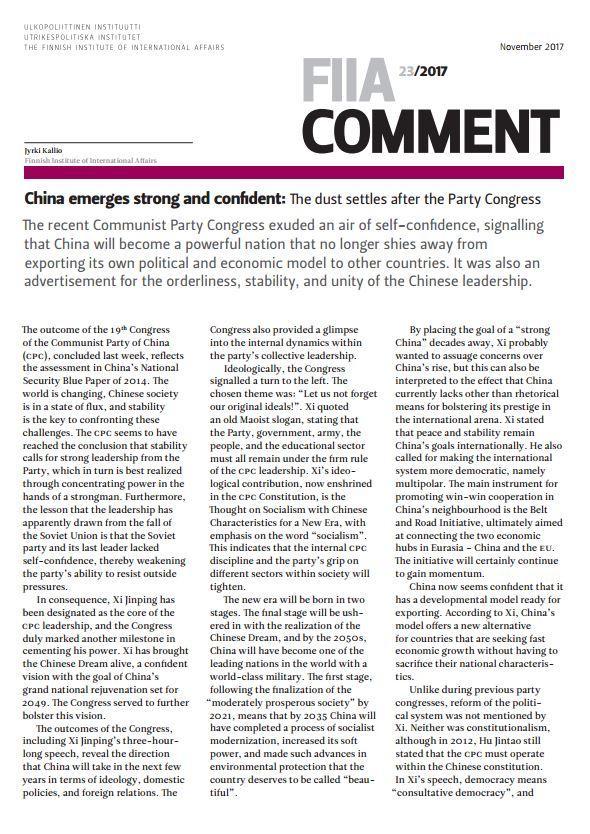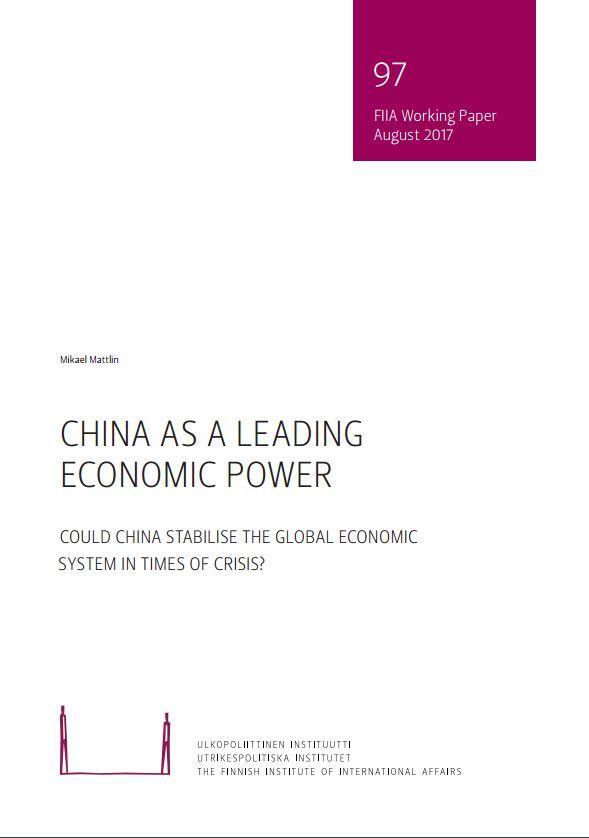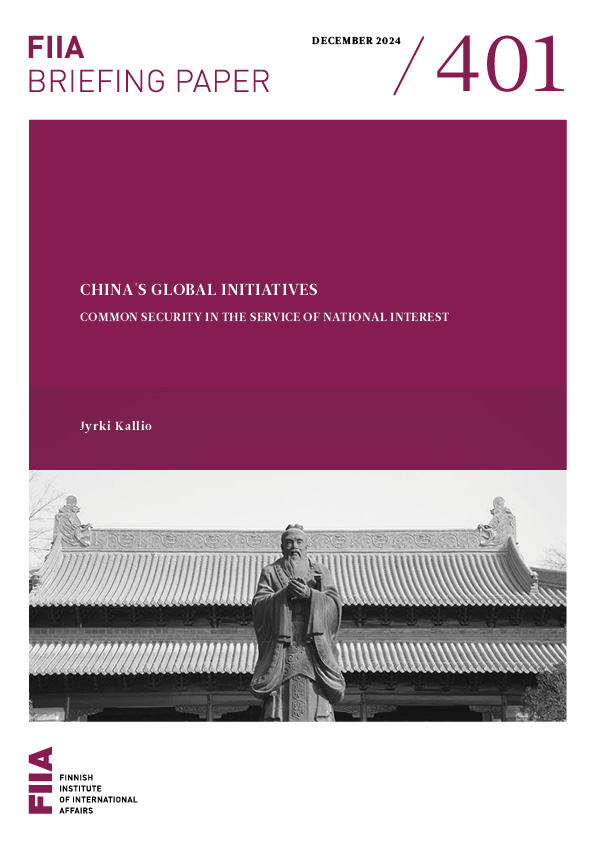Xi Jinping Thought is aimed at guiding China both domestically and internationally. The goal is China’s national rejuvenation, which will break the global dominance of Western civilization. The revival must allegedly be led by a strong ideology guided by a strong and charismatic leader: Xi Jinping.
Based on the ancient Chinese ideal of “great unity under Heaven”, Xi’s long-term goal for China is the creation of a “community of a common destiny for Mankind”. So far, this idea has no concrete manifestations on the global scale.
Through the Belt and Road Initiative, China is building a regional community of common destiny in Central and Southeast Asia. This is both an indirect challenge to the existing “Western” system, and a step in delineating China’s sphere of influence.
From the Chinese perspective, the principal contradiction in international relations may be between Chinese and universal values. In the future, ideological competition is likely to play a bigger role in China’s relations with the West.
Since the 19th Congress of the Communist Party of China (CPC) in October 2017, which enshrined “Xi Jinping Thought on Socialism with Chinese Characteristics for a New Era”, the world has been asking what is “Xi Jinping Thought” and where will it take China? This paper presents recent examples of Chinese self-understanding with regard to China’s role in the contemporary world.
On 15 January 2018, the mouthpiece of the CPC, Renmin Ribao (“the People’s Daily”), published an enigmatic “declaration” on its front page. The main message was two-fold. First, the prospects for China are now great, and the Chinese should grasp the historical opportunity. This contrasts with the adage of Deng Xiaoping (d. 1997), which called upon China to wait for the right time. Second, the opportunity is not only about occasion but also about chance. This chimes with Xi Jinping’s favourite line of thinking that chance is not luck but comes with proactively creating the right moment, or making one’s own destiny.
According to Xi Jinping, China’s destiny is the realization of the Chinese Dream. It calls for the “great rejuvenation of the Chinese nation”, culminating in 2049 when the People’s Republic will celebrate its 100th anniversary. The rejuvenation will give rise to a China which “has become a global leader in terms of composite national strength and international influence”.1
The declaration can be interpreted as giving the go-ahead for the Chinese to start grasping the opportunity. While the call is domestic, the goals are international. By drawing a comparison between “global chaos” and “Chinese order”, the declaration invites the Chinese people to feel proud of themselves, and to project that pride outwards. Some prominent Chinese thinkers have already come forward with their respective inputs, quite possibly prompted by the go-ahead.
A dissection of Xi Jinping thought
Professor Qiang Shigong, legal scholar from the Peking University Law School and public intellectual, offers an excellent analysis of Xi Jinping Thought from a Chinese perspective in a journal article published in January 2018.2 Qiang is known for his nationalistic tendencies and neoconservative legal thought, as well as his promotion of the unity between Chinese value systems, such as Confucianism and Maoism.
The starting point of Qiang’s analysis is Xi Jinping’s speech delivered at the CPC Congress. On the basis of the speech, Qiang presents Xi as the driving force of a third era in the history of the CPC. Mao Zedong (d. 1976) led China to rise to its feet, Deng Xiaoping led the country in creating wealth, and Xi is now leading China in becoming powerful. Qiang also mentions Jiang Zemin (but pays no attention to Hu Jintao), and states that since Jiang introduced “the great revival of the Chinese nation”, China has started to enter the fifth period of overall revival. The previous four were pairs of dynasties (presumably because during their reigns, the Chinese empire was both culturally and politically strong), namely the Shang and Zhou dynasties (ca. 1600 BCE–771 BCE), the Qin and Han dynasties (221 BCE–220 CE), the Tang and Song dynasties (618–1127), and the Ming and Qing dynasties (1368–1911).
The idea of a revival derives from the Chinese understanding of history. According to Qiang, it differs fundamentally from the Western understanding. Whereas the West harbours a deterministic belief in the “end of history”, both ancient Chinese philosophy and Marxism share the idea of an ever-changing state of the world, driven by contradictory movements that dialectically produce developments and changes. Each revival era is part of the same process, contributing to a deeper understanding of the “historically existing” rule – enshrined in Confucian classics – of families being the roots of the state, and states being the roots of All Under Heaven (Tianxia).
Tianxia, literally ‘All Under Heaven’, is an ancient Chinese concept which, depending on the context, can be understood as referring to the empire, a sphere of influence, or even the world. Ideally, Tianxia is a community of values rather than a union by force, and popular usage of the word Tianxia indicates that there can be several Tianxias in existence at the same time, ours and theirs. The concept is linked with the traditional belief in Heaven as an impersonal but moral actor, which grants a worthy ruler his mandate to rule, namely the “Heavenly Mandate”.
Revival based on ideology
The process leading to the revival can and must be strategically directed. Qiang refers to the need for a strong leader by stating that it is a Western fallacy to see ‘the rule of law’ and ‘the rule of men’ as antagonistic. Instead, they are complementary, due to the importance of leaders providing ideas and morals. This echoes Qiang’s and Xi’s views on constitutionalism, which renders the law firmly subject to the CPC rule.
Qiang claims that thought is at the heart of leading the revival. Xi’s Thought is based on communism. In Qiang’s analysis, Xi’s communism is “a kind of ideal faith or a spiritual belief”. Its goal in some distant future is not the realization of the Marxist utopia, but an era when “great communality under Heaven” (Tianxia datong) prevails. Mao already made the connection between this ancient ideal, referring to a society where all have what they need, and the communist belief in the liberation of all humanity. For Xi, making this same connection helps to bind China’s fate and the fate of communism together. In Qiang’s words, “communism’s highest spiritual pursuit and the realization of the great revival of the Chinese nation are mutually supporting and complementary”. Socialism has saved China, now China must save socialism.
Qiang explains that, on the one hand, China must renew its ancient traditions on the basis of socialism. On the other hand, China is now undertaking the project of the modernization of socialist construction. China has the confidence to do so, thanks to “the depths of the Chinese cultural tradition”, says Qiang. This challenges the idea that the “Western” civilization is at the end of history, and “means breaking the global dominance of Western civilization in the past 500 years in the cultural sense, and hence ushering in a new era in human civilization”.
Qiang recalls Xi’s speech at the 19th CPC Congress, in which he stated: “History looks kindly on those with resolve, with drive and ambition, and with courage”. The resolve that Qiang is referring to is ideological in nature. Dialectical materialism in its Chinese application – there is always a struggle between contradictions, but it is necessary to differentiate the primary contradiction from the secondary ones at any given time – must not be forgotten. In Qiang’s analysis, the Soviet Union fell because it lost faith in contradictions. Instead, it promoted peaceful competition with the USA, and transformed the Soviet Communist Party into the “Party of the whole people”.
Qiang argues that China has previously stumbled onto the Soviet road by letting the market economy become disconnected from the Party-led superstructure in some areas, and by promoting such erroneous beliefs as democracy or the rule of law, superseding the CPC rule. He also complains that the 18th CPC Congress – held under the leadership of Hu Jintao – was unable to define the primary values which should guide China’s development, but listed a hodgepodge instead, including some values of traditional Chinese culture, some of socialism under the Mao era, and some of Western liberalism.
Qiang therefore believes that the most important task ahead is to construct a coherent set of core values. This should be done by merging Marxism with traditional Chinese culture. The latter is to be defined by China’s traditional Confucian culture in particular. In this way, the revival of the core values will make China’s revival synonymous with that of Chinese civilization, concluded Qiang.
Foreign policy based on Xi Jinping thought
Qiang Shigong’s analysis also touches upon Xi Jinping’s foreign policy goals. Qiang claims that in the West-dominated civilization, “internal order was the result of class dominion, and international order the result of the domination of power”. Instead, Xi Jinping has stressed the necessity to build a new system of international governance based on principles stressing cooperation instead of rivalry, and coexistence instead of hegemony.
According to Qiang, these principles are rooted in ancient Chinese thought, including the adages “All Under Heaven belongs to all” (Tianxia wei gong), and “harmony without uniformity” (he er bu tong). The latter is also embodied in the Five Principles of Peaceful Coexistence, which have been the backbone of Chinese foreign policy since the 1950s. They stress state sovereignty and deny the right to interfere in other states’ internal affairs.
All in all, Xi is in Qiang’s view aiming to construct a Tianxia-based global order. Qiang further says that the system of international law in Tianxia is the tributary system. Imperial China’s relations with the outside world before the colonial era and Western domination were guided by the idea that other kingdoms could secure trade and peace with the Chinese empire in return for their symbolic obeisance. In English, this complex and amorphous set of “tit for tat” practices is known as the tributary system. According to Qiang, the system maintained diversity within unity through its capacity of “absorbing different peoples, cultures and religious beliefs”. In this way, the tributary system was supposedly different from the violent colonialism of Western nations.
As if taking their cue from the January “declaration” and Qiang, two prominent Chinese foreign-policy thinkers known for their ideas of connecting traditional Chinese ideas with contemporary international relations, Yan Xuetong and Zhao Tingyang, came forward with their own inputs in early February. They were published as opinion pieces in The World Post, a media platform in partnership with The Washington Post and the Berggruen Institute.
Both Yan and Zhao have written extensively on the traditional Chinese worldview, and both are known for their preference for the Zhou era (ca. 1045–256 BCE) as a source of inspiration. Yan’s focus is on the Warring States Era (475–221 BCE) which, as the name implies, bears a certain resemblance to classical Greece with its city-states. In contrast, Zhao looks at the early Zhou era, much of which is shrouded in legend, where he finds the ideational roots of a universalist, harmonious world system in which All Under Heaven live in unity.
Yan’s argument in the opinion piece3 is that China’s preference is peaceful competition, not rivalry. He also states that China is not aiming to engage in an ideological contest with the USA. Furthermore, he makes reference to the “community of common destiny” concept, which he explains as the need for every member of the international community to share the responsibility for global governance.
Although not Xi Jinping’s invention, the “community of a common destiny for Mankind” has been a stock phrase since 2012 in the rhetoric concerning China’s foreign relations during his era. The phrase has recently been included in several UN documents,4 which marks a hard-fought achievement of Chinese diplomacy. In March 2018, the “community of a common destiny for Mankind” was even included in the Chinese Constitution. The new text in the Preamble reads: “China consistently carries out an independent foreign policy, adheres to the five principles of mutual respect for sovereignty and territorial integrity, mutual non-aggression, non-interference in each other’s internal affairs, equality and mutual benefit, peaceful coexistence, ..., and works to build a community with a shared future for humanity”.5
Yan does not make any reference to Tianxia in his opinion piece, but in a recent, longer academic article,6 he returns to his pet idea of the “Kingly Way”, which he calls “humane authority”. This is a Confucian concept referring to a king who relies on moral not physical force. The Kingly Way is inherently related to the Tianxia system because the latter needs to have a centre, something around which to set and safeguard its common values. In the light of traditional Chinese thinking, such as that endorsed by both Yan and Zhao, only a humane and morally upright authority has the kind of soft power needed to become the centrifugal force of the global order. In Yan’s view, traditional Chinese values, “such as benevolence, righteousness and rites” may amalgamate with liberalist values, such as equality, democracy and freedom, and produce a new set of modern values of humane authority. Equality would thus become fairness, democracy would become justice, and freedom would become civility.
While Yan is promoting some sort of relativist, fettered liberalism, or “liberalism with Chinese characteristics”, Zhao wants7 to change the principles of governing the world from the maximization of self-interest to the minimization of mutual hostility. According to him, “Tianxia peace” will be possible only if we follow the Confucian understanding that being is only defined in relation to others, not by individual existence. Only then could “relational rationality” take priority over individual rationality in politics and the economy.
What is completely lacking in Zhao’s and Yan’s articles is a discussion about the potential problems inherent in using tradition for contemporary goals. Zhao makes some hyperbolical statements. He calls the Zhou China’s “longest-standing” dynasty and claims that the dynasty’s practice of transforming hostility into hospitality by means of the Tianxia system proved that “perpetual peace” is possible. Most historians would beg to differ. Zhao also neglects to mention the dark side of the Tianxia system. Its stability was based on all actors knowing their places and roles, and playing along, which they did as long as the centrifugal force was too strong to be challenged. In essence, the system was static, and served the interests of the central power.
Not just any academic discussion
The views presented above are not just any academic discussion. Zhao’s views have considerable prominence both in China and abroad. Whenever the “Chinese worldview” is discussed, the Tianxia concept is mentioned, and Zhao’s name along with it. Among Chinese international relations theorists, Yan is the best known. With regard to Qiang’s article, he must believe he has strong backing for his views at a high level, or else he would not go out in public explaining the national leader’s thoughts. Moreover, the foreign policy ideas presented by Zhao, Yan and Qiang seem to reflect the thinking of Wang Huning.
Wang Huning was elected Member of the Politburo Standing Committee at the 19th CPC Congress. Before that, he was known to have worked as a foreign policy advisor for both Hu Jintao and Xi Jinping, and he is regarded as the chief architect of Xi’s Chinese Dream. Wang is also among the earliest to have introduced the concept of soft power to the Chinese. Like Yan Xuetong, Wang regards cultural competition as an important part of international competition between states, and sees a strong link between China’s traditional culture and its soft power.8 Wang’s views have thus quite aptly been regarded as those of a “Communist Confucian”.9
Central to the link between China’s traditional culture and its soft power is the “Kingly Way” concept, a kind of charismatic rule. This is not unrelated to Qiang Shigong’s call to recognize the importance of the “rule of men”. He is in effect saying that Xi follows the Kingly Way and consequently not only has domestic legitimacy but also international soft power.
Wang Huning’s growing political prominence gives further clout to the Tianxia ideal, having relevance for China’s actual foreign policy. Naturally, it is also of great significance that Xi Jinping himself has referred to Tianxia. The most notable example is his address to the United Nations General Assembly in September 2015, where he spoke about “a community of a common destiny for Mankind”. He then said, in the official translation, “the greatest ideal is to create a world truly shared by all”. In Chinese, the “world truly shared by all” is Tianxia wei gong.
No to universalism, yes to relativism
In international relations-related texts written in China today, the Tianxia ideal is presented as an alternative to the contemporary international system, which is regarded as flawed and plagued by conflicting national interests. Seen from the Chinese perspective, the Westphalian system merely signifies a loose collection of states driven by their own national interests. However, what is missing from the Chinese discussion – the recent articles referred to in this paper included – is a realistic definition of what a world based on the Tianxia system would actually look like, and a roadmap for getting there.
Instead, the concept is used to promote “the democratization of international relations”. This has been part of China’s rhetoric during the last two decades. Tianxia has thus become a preferred term for multipolarism, with China as one of the poles. Furthermore, the community of a common destiny is linked with non-interference in other countries’ internal affairs, as the revised Chinese Constitution Preamble shows. In a similar vein, the White Paper on Asia-Pacific Security Cooperation, issued in 2017, stated that the “rules of individual countries should not automatically become ‘international rules’”.10 This reflected the sentiment articulated in an internal Party document in 2013: “Promoting ‘universal values’ in an attempt to weaken the theoretical foundations of the Party’s leadership”.11
Qiang Shigong mentioned the necessity for the CPC to identify the principal contradiction. One could argue that in regard to international relations, the principal contradiction from the Chinese perspective is the perceived Western dominance and the idea of universal values. This is manifested in the Chinese official rhetoric, which uses liberalist concepts, such as democracy or the rule of law, but “fetters” them by adding the attribute “with Chinese characteristics”. China promotes relativism instead of universalism, so that it need not feel ideologically challenged. This means that there is increasingly an element of ideological competition in the relations between China and its perceived “West”.
Tianxia in concrete terms?
What concrete manifestations, if any, does the Tianxia tributary ideal have so far? While Tianxia is largely an abstract idea, its modern spiritual offspring, the “community of a common destiny for Mankind” has links with the Chinese way of acting in the international arena.
In its neighbourhood in Central and Southeast Asia, China is in effect building its own Tianxia with the help of the Belt and Road Initiative (BRI). It is China’s first and foremost strategic project, and is directly related to the CPC’s legitimacy. The goal of the BRI is to support China’s economic growth by enhancing a China-centred economic integration in South and Central Asia, as well as improving logistical ties between the EU and China. According to China, the BRI is mutually beneficial and based on win-win cooperation. With such a tit-for-tat principle at its core, it can be regarded as the modern equivalent of a tributary system.
China’s global goal, the “community of a common destiny”, is a long way off, and its meaning remains undefined. It also contains inherent contradictions. First, Tianxia is ill-adapted to be a model for a global community because it cannot exist without a centre. While China is promoting state sovereignty on the one hand, it is promoting the right of big powers to have their own spheres of influence on the other.While the BRI, and its supporting institutions, such as the Asian Infrastructure Investment Bank, do not directly challenge the existing “Western” system on a global scale, they signify an effort by China to make its neighbourhood its own backyard. They are thus tools for “multilateralism with Chinese characteristics”.
Second, Tianxia thinking implies that different value systems should coexist peacefully. At the same time, Tianxia should ideally be a community of values, and traditionally it was the centre’s right to define the values. The BRI is not just about the economy or geopolitics, it is also part of China’s ideological competition. As Xi Jinping said during the 19th CPC Congress, the Chinese model offers a new option for countries who want fast development while preserving their own independence.
Third, while history should be a never-ending dialectical process according to the Chinese understanding, the CPC still upholds the realization of communism, or the great communality under Heaven, as its goal. That equates to placing the revival of the Chinese civilization at the end of history. By binding the fates of socialism and China together, Xi Jinping is in effect stating that the final goal is a Chinese-led global order. Therefore, in the long term, China’s revival is destined to become a challenger to Western liberal democratic systems.
Furthermore, since the Tianxia ideal signifies a departure from Westphalian thinking based on nation-states and hard borders, we should see China’s actions reflecting at least some movement in that direction. It is not difficult to find foreign policy-related issues which serve as litmus tests of China’s intentions.
First, there is the Taiwan issue. Here, Westphalian thinking seems to have the upper hand, since the only acceptable solution for the CPC is Taiwan’s accretion to China as a province, and not for some confederalist setting, for instance. Second, if China abandons its current vagueness over its nine-dash line in the South China Sea in favour of setting up a proper maritime border, this would indicate a preference for hard borders. Third, the harsh re-education campaigns ongoing in Xinjiang point to China aiming to create a nation-state by reinforcing a single Chinese national identity over the minority ones. All of these aspects need to change before the Tianxia ideal has any credibility as the heart of China’s international-relations thinking.
Endnotes
1 'Full text of Xi Jinping’s report at 19th CPC National Congress'. ChinaDaily.com. cn, 4 Nov. 2017. http://www.chinadaily.com.cn/china/19thcpcnationalcongress/2017-11/04/content_34115212.htm.
2 The article has been translated by David Ownsby and published in The China Story, 11 May 2018. https://www.thechinastory.org/cot/jiang-shigong-on-philosophy-and-history-interpreting-the-xi-jinping-era-through-xis-report-to-the-nineteenth-national-congress-of-the-ccp/.
3 'Trump can’t start a cold war with China, even if he wants to'. The WorldPost, 6 Feb. 2018. https://www.washingtonpost.com/news/theworldpost/ wp/2018/02/06/china-trump/.
4 See e.g. resolution E/RES/2017/11 adopted by the Economic and Social Council on 8 June 2017. The phrase was translated as “a shared future, based upon our common humanity”.
5 This excerpt is from the Xinhua translation of the CPC proposal (http://www. xinhuanet.com/english/2018-02/25/c_136999410.htm).
6 'Chinese Values vs. Liberalism: What Ideology Will Shape the International Normative Order?'. The Chinese Journal of International Politics, Vol. 11, Issue 1, 1 March 2018: 1–22. https://doi.org/10.1093/cjip/poy001.
7 'Can this ancient Chinese philosophy save us from global chaos?'. The WorldPost, 7 Feb. 2018. https://www.washingtonpost.com/news/theworldpost/ wp/2018/02/07/tianxia/.
8 Wang, Hongying & Lu, Yeh-Chung. 'The Conception of Soft Power and its Policy Implications: a comparative study of China and Taiwan'. Journal of Contemporary China, 17 (56): 425–447, p. 428. Lin Mao. 'Between Tradition and Modernity: Wuzhen and China’s Soft Power in the 21st Century'. Journal of Literature and Art Studies, Nov. 2017, Vol. 17, No.11: 1457–1477, p. 1459. doi.org/10.1080/10670560802000191.
9 Plate, Tom. 'Can China’s ideology tsar, Wang Huning, be the steadying hand in Sino-US relations?'. SCMP.com, 6 Nov. 2017. http://www.scmp.com/comment/insight-opinion/article/2118604/can-chinas-ideology-tsar-wang-huning-be-steadying-hand-sino.
10 'China’s Policies on Asia-Pacific Security Cooperation'. Ministry of Foreign Affairs of the People’s Republic of China, 11 Jan. 2017. http://www.fmprc.gov.cn/mfa_eng/zxxx_662805/t1429771.shtml.
11 'Document 9: A ChinaFile Translation'. 8 Nov. 2013. http://www.chinafile.com/document-9-chinafile-translation.





